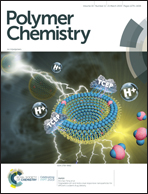A novel hydroxyl-containing polyimide as a colorimetric and ratiometric chemosensor for the reversible detection of fluoride ions†
Abstract
A novel hydroxyl-containing polyimide (PI-OH) has been successfully synthesized and subsequently used as a new colorimetric and ratiometric chemosensor for the detection of F− with high selectivity and a fast response time. The ratiometric absorbance changes of the chemosensor PI-OH in DMSO solution show a linear response to F− in the concentration range of 0–0.50 mM with a detection limit of 1.79 μM, which provides a quantitative method for F− detection. 1H NMR titration and DFT calculation studies confirm the F− sensing mechanism involves H-bond interactions and subsequent deprotonation in the chemosensor. Moreover, the chemosensor PI-OH in DMSO solution can be reversed many times and applied to the visual detection of F−. Finally, PI-OH film has been fabricated for real-time visualization of F− with high selectivity and sensitivity. The F− bonded to the PI-OH film can be easily removed by immersing it in acidic solution to recover the sensing ability to F−. X-ray photoelectron spectroscopy and energy dispersive spectroscopy analysis indicate that hydroxyl groups in the PI-OH film can bond to F− and the bonded F− can be removed quantitatively. This work provides not only a novel PI film-based sensor device for the visual and reversible detection of F− with high-efficiency, but also a promising F− extractor.



 Please wait while we load your content...
Please wait while we load your content...